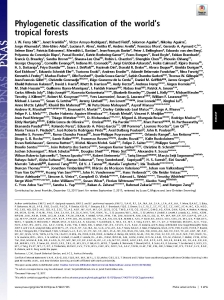Slik J.W.F. et al.
Knowledge about the biogeographic affinities of the world’s tropical forests helps to better understand regional differences in forest structure, diversity, composition, and dynamics. Such understanding will enable anticipation of region-specific responses to global environmental change. Modern phylogenies, in combination with broad coverage of species inventory data, now allow for global biogeographic analyses that take species evolutionary distance into account. Here we present a classification of the world’s tropical forests based on their phylogenetic similarity.
We identify five principal floristic regions and their floristic relationships: (i) Indo-Pacific, (ii) Subtropical, (iii) African, (iv) American, and (v) Dry forests. Our results do not support the traditional neo- versus paleotropical forest division but instead separate the
combined American and African forests from their Indo-Pacific counterparts. We also find indications for the existence of a global dry forest region, with representatives in America, Africa, Madagascar, and India. Additionally, a northern-hemisphere Subtropical forest region was identified with representatives in Asia and America, providing support for a link between Asian and American northernhemisphere forests.
Consultez la notice complète de l’article sur ORBi

